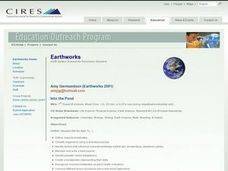Curated OER
Draw your Conclusions
Students analyze data from a student discussion website and write a report on the outcome of an investigation regarding their local water quality. As part of a larger unit students then post the summary of their investigation on the...
Curated OER
Build a Bug
Learners design an ideally adapted macroinvertebrate to live in a water habitat. They illustrate their animal, name it and specify the adaptations it has that enable it to survive.
Curated OER
Into the Pond
Seventh graders use a pond to explore macroinvertebrates and other organisms. They use a dichotomous key to classify the organisms and maintain a journal recording their findings.
Curated OER
Determination of Overall Water Quality Using a Quantitative Macroinvertebrate Survey
Young scholars examine water samples from a local stream. They identify various types of macroinvertebrates found in that water ecosystem and perform a quantitative macroinvertebrate survey to determine the stream's water quality.
Curated OER
Do Human Practices Affect Water Quality?
Learners determine if human practices have any noticeable effects on the quality of stream life as measured by the presence of certain macroinvertebrates. They collect, preserve and identify macroinvertibrate samples and quantify the data.
Globe
The Globe Program: Discoveries at Willow Creek [Pdf]
Join Anita, Dennis and Simon as they take a field trip to Willow Creek. This visit to the creek is slightly different than their first encounter there--discover why by reading this interesting tale!
Utah Education Network
Uen: If Bugs Could Talk Bugs Don't Bug Me
Evaluate the quality of a "water sample" and form a hypothesis about the land use near the location their "water sample" was collected.
Utah Education Network
Uen: Macroinvertebrate Simon Says
Introduces students to the feeding adaptations found in aquatic macroinvertebrates.
Globe
The Globe Program: Water Module
Learning activities allow students to learn about tools for making science observations such as a magnifying lens and ruler. Then students describe how macroinvertebrates are adapted to their aquatic environment.
Science Education Resource Center at Carleton College
Serc: Healthy Waters
By the end of this lesson, young scholars will understand how we can use macroinvertebrates to determine the quality of water in a river or stream.
Science Education Resource Center at Carleton College
Serc: Investigating Macroinvertebrates: How Clean Is Our Lake?
In this outdoor field study, students will collect and identify as many types of macro invertebrates that they find in Lake Bemidji using an identification key. Additionally students will create investigable questions regarding the macro...
Other
Freshwater Ecology
This is a comprehensive and detailed site providing information on aquatic macroinvertebrates. The emphasis is on biomonitoring of water quality through quantitative assessment of numbers and types of small aquatic organisms.
Center for Innovation in Engineering and Science Education, Stevens Institute of Technology
Ciese Collaborative Projects: Bucket Buddies: Environmental Study
Bucket Buddies is an opportunity for young scholars to participate in a world-wide environmental study. By identifying organisms in pond water, participating classes can compare their findings, and look for relationships in data. In...
Utah Education Network
Uen: Who Lives in the Water? Stream Side Science
In this exercise, students will collect and observe macroinvertebrates in an aquatic system. They will record and summarize their findings.
Environmental Education for Kids
Eek!: Teacher Resources: Critter Search
In this activity, students will identify aquatic insects and animals that live in a stream or river, learn about the water quality based on the type of macroinvertebrates collected, and return the collected critters to the water.







![The Globe Program: Discoveries at Willow Creek [Pdf] eBook The Globe Program: Discoveries at Willow Creek [Pdf] eBook](https://d15y2dacu3jp90.cloudfront.net/images/attachment_defaults/resource/large/FPO-knovation.png)



